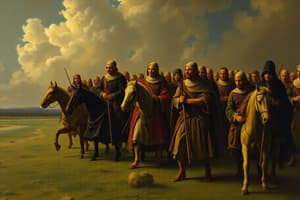Podcast
Questions and Answers
What primary objective did William the Conqueror have during the Harrying of the North?
What primary objective did William the Conqueror have during the Harrying of the North?
- To establish peace with the local population
- To consolidate Norman power and prevent uprisings (correct)
- To forge alliances with Northern rulers
- To promote agricultural development in Northern England
What was one of the major impacts of the Harrying of the North on the population?
What was one of the major impacts of the Harrying of the North on the population?
- Enhanced infrastructure supporting trade
- Severe famine due to agricultural destruction (correct)
- A population boom in Northern England
- Increase in wealth among local inhabitants
Which military strategy was employed by William during the Harrying of the North?
Which military strategy was employed by William during the Harrying of the North?
- Naval blockades to isolate the region
- Formation of a defensive alliance with locals
- Use of guerilla tactics by local troops
- A scorched earth policy targeting resources (correct)
What were the long-term consequences of the Harrying of the North for land ownership?
What were the long-term consequences of the Harrying of the North for land ownership?
How did the Harrying of the North influence later cultural identity in Northern England?
How did the Harrying of the North influence later cultural identity in Northern England?
Which military tactic involved the use of heavily armored cavalry in the Harrying of the North?
Which military tactic involved the use of heavily armored cavalry in the Harrying of the North?
What significant change occurred in governance as a result of the Harrying of the North?
What significant change occurred in governance as a result of the Harrying of the North?
In what way is the Harrying of the North portrayed in literature and historical accounts?
In what way is the Harrying of the North portrayed in literature and historical accounts?
Flashcards are hidden until you start studying
Study Notes
Historical Context
- The Harrying of the North occurred between 1069 and 1070, under William the Conqueror.
- It was a response to the Northern rebellions against Norman rule following the conquest of England in 1066.
- Northern England, particularly Yorkshire, was resistant to Norman authority, leading to significant unrest.
- William aimed to consolidate his power and prevent further uprisings by displaying military might.
Impact On Population
- Widespread devastation of the North; villages were destroyed, crops burned, and livestock killed.
- It is estimated that a significant portion of the population was killed or displaced.
- The surviving population faced famine due to the destruction of agricultural resources.
- Long-term demographic changes, as many areas were depopulated or saw a decline in local economies.
Military Strategies
- William employed a scorched earth policy, targeting resources to weaken rebel support.
- Use of brutal military tactics, including the slaughter of civilians and destruction of settlements.
- Deployment of a heavily armored cavalry to intimidate and control the population.
- Building of castles to establish Norman authority and prevent further uprisings.
Aftermath And Consequences
- The immediate aftermath saw a period of severe hardship in the North, leading to increased discontent.
- Establishment of Norman control solidified, with land redistribution favoring Norman nobles.
- Long-term consequences included the integration of Northern England into the feudal system.
- Significant changes in land ownership and governance, fostering resentment among the local populace.
Cultural Significance
- The event marked a pivotal point in English history, symbolizing the brutality of Norman rule.
- Contributed to the legacy of resistance in the North, influencing later rebellions and cultural identity.
- The Harrying is often referenced in literature and historical accounts as a cautionary tale of tyranny.
- It laid the groundwork for subsequent changes in English law, governance, and societal structure.
Historical Context
- The Harrying of the North took place from 1069 to 1070 under William the Conqueror.
- This campaign responded to Northern rebellions against Norman rule post-1066 conquest.
- Yorkshire was notably resistant, leading to significant turmoil in the region.
- William sought to assert control and deter future insurrections through displays of military power.
Impact On Population
- The campaign resulted in widespread devastation: villages destroyed, crops set aflame, livestock exterminated.
- A considerable portion of the Northern population was either killed or displaced.
- Surviving inhabitants faced famine due to the extensive destruction of agricultural resources.
- Long-term demographic changes occurred, with many areas experiencing depopulation and economic decline.
Military Strategies
- A scorched earth policy was adopted to erode support for rebel forces.
- Brutal military tactics were employed, including civilian massacres and settlement demolitions.
- Heavily armored cavalry was used to intimidate and assert control over the populace.
- Castles were constructed to reinforce Norman authority and prevent further uprisings.
Aftermath And Consequences
- The immediate aftermath left the Northern region in severe hardship, increasing local discontent.
- Norman control was solidified through land redistribution beneficial to Norman nobles.
- Long-term effects included the integration of Northern England into the feudal system.
- Shifts in land ownership and governance contributed to growing resentment among local communities.
Cultural Significance
- The Harrying of the North is viewed as a critical moment in English history, illustrating the cruelty of Norman rule.
- The event influenced a legacy of resistance in the North, shaping future rebellions and cultural identity.
- It is frequently depicted in literature and history as a warning against tyranny.
- The campaign laid foundational changes in English law, governance, and societal structure.
Studying That Suits You
Use AI to generate personalized quizzes and flashcards to suit your learning preferences.

